Detailed Examination of Procurement Methods in Construction Projects
VerifiedAdded on 2020/03/23
|15
|2793
|285
Report
AI Summary
This report provides a comprehensive overview of procurement methods in construction projects. It begins with an executive summary, followed by an introduction that highlights the importance of selecting the most suitable procurement method for a given project. The report then delves into the results and findings, exploring various methods such as open tendering, restricted tendering, and request for proposal (RFP). For each method, the report outlines its advantages and disadvantages, providing a detailed comparison to aid in decision-making. The discussion includes the conditions under which each method is best applied and the factors influencing the selection process, such as cost, time, and project complexity. The report concludes with an analysis and recommendations, emphasizing the importance of considering both short-term and long-term project goals to ensure the success of the construction project. The report is supported by references to relevant literature.
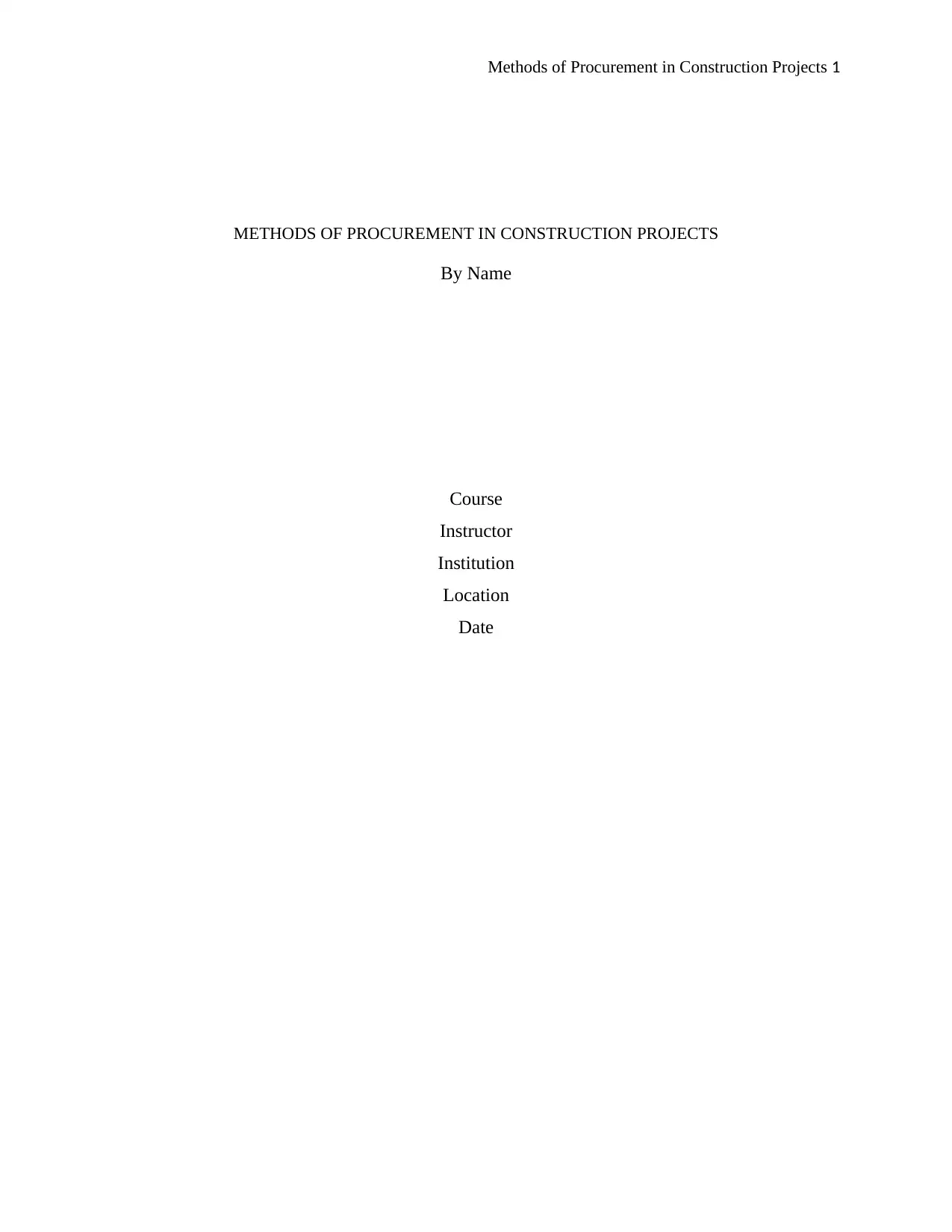
Methods of Procurement in Construction Projects 1
METHODS OF PROCUREMENT IN CONSTRUCTION PROJECTS
By Name
Course
Instructor
Institution
Location
Date
METHODS OF PROCUREMENT IN CONSTRUCTION PROJECTS
By Name
Course
Instructor
Institution
Location
Date
Paraphrase This Document
Need a fresh take? Get an instant paraphrase of this document with our AI Paraphraser
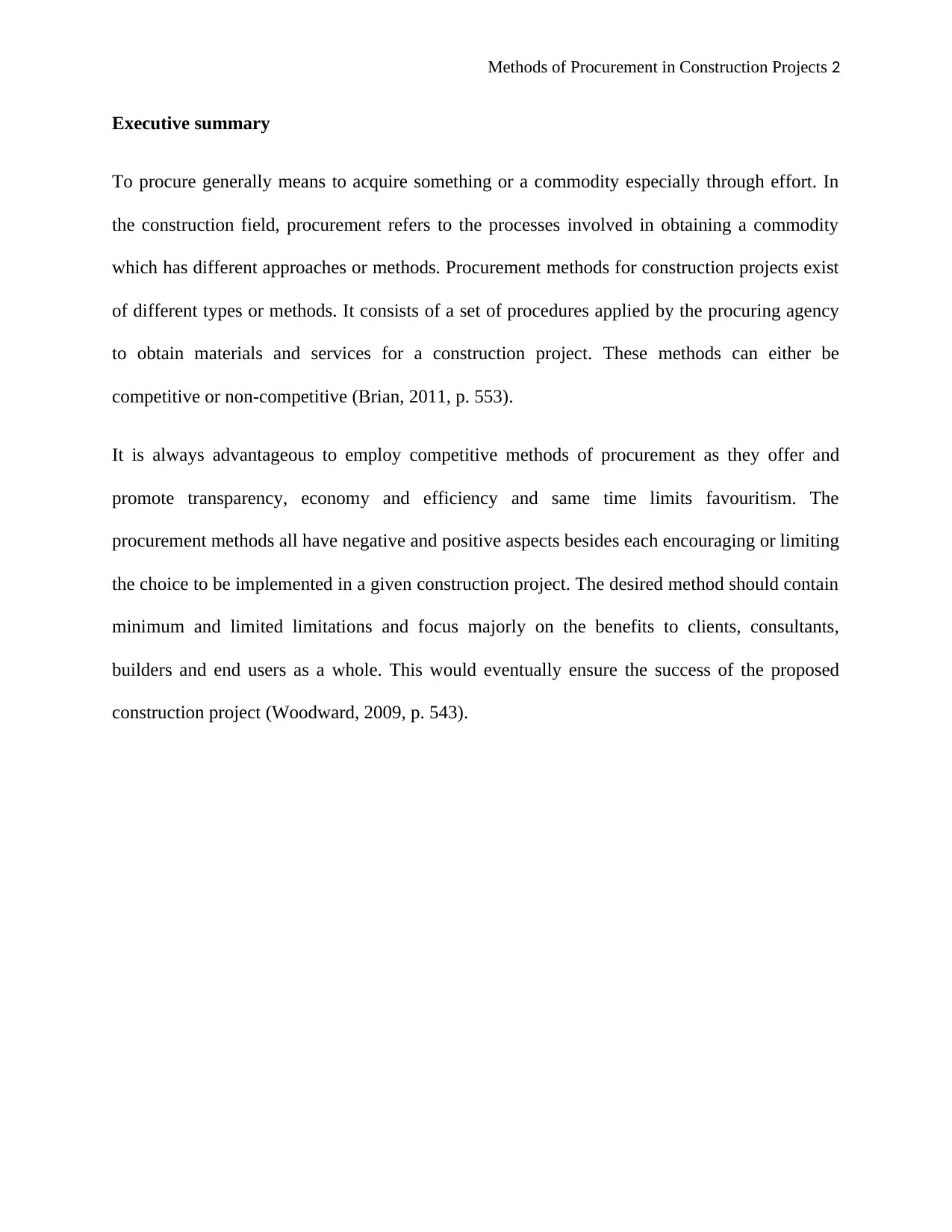
Methods of Procurement in Construction Projects 2
Executive summary
To procure generally means to acquire something or a commodity especially through effort. In
the construction field, procurement refers to the processes involved in obtaining a commodity
which has different approaches or methods. Procurement methods for construction projects exist
of different types or methods. It consists of a set of procedures applied by the procuring agency
to obtain materials and services for a construction project. These methods can either be
competitive or non-competitive (Brian, 2011, p. 553).
It is always advantageous to employ competitive methods of procurement as they offer and
promote transparency, economy and efficiency and same time limits favouritism. The
procurement methods all have negative and positive aspects besides each encouraging or limiting
the choice to be implemented in a given construction project. The desired method should contain
minimum and limited limitations and focus majorly on the benefits to clients, consultants,
builders and end users as a whole. This would eventually ensure the success of the proposed
construction project (Woodward, 2009, p. 543).
Executive summary
To procure generally means to acquire something or a commodity especially through effort. In
the construction field, procurement refers to the processes involved in obtaining a commodity
which has different approaches or methods. Procurement methods for construction projects exist
of different types or methods. It consists of a set of procedures applied by the procuring agency
to obtain materials and services for a construction project. These methods can either be
competitive or non-competitive (Brian, 2011, p. 553).
It is always advantageous to employ competitive methods of procurement as they offer and
promote transparency, economy and efficiency and same time limits favouritism. The
procurement methods all have negative and positive aspects besides each encouraging or limiting
the choice to be implemented in a given construction project. The desired method should contain
minimum and limited limitations and focus majorly on the benefits to clients, consultants,
builders and end users as a whole. This would eventually ensure the success of the proposed
construction project (Woodward, 2009, p. 543).
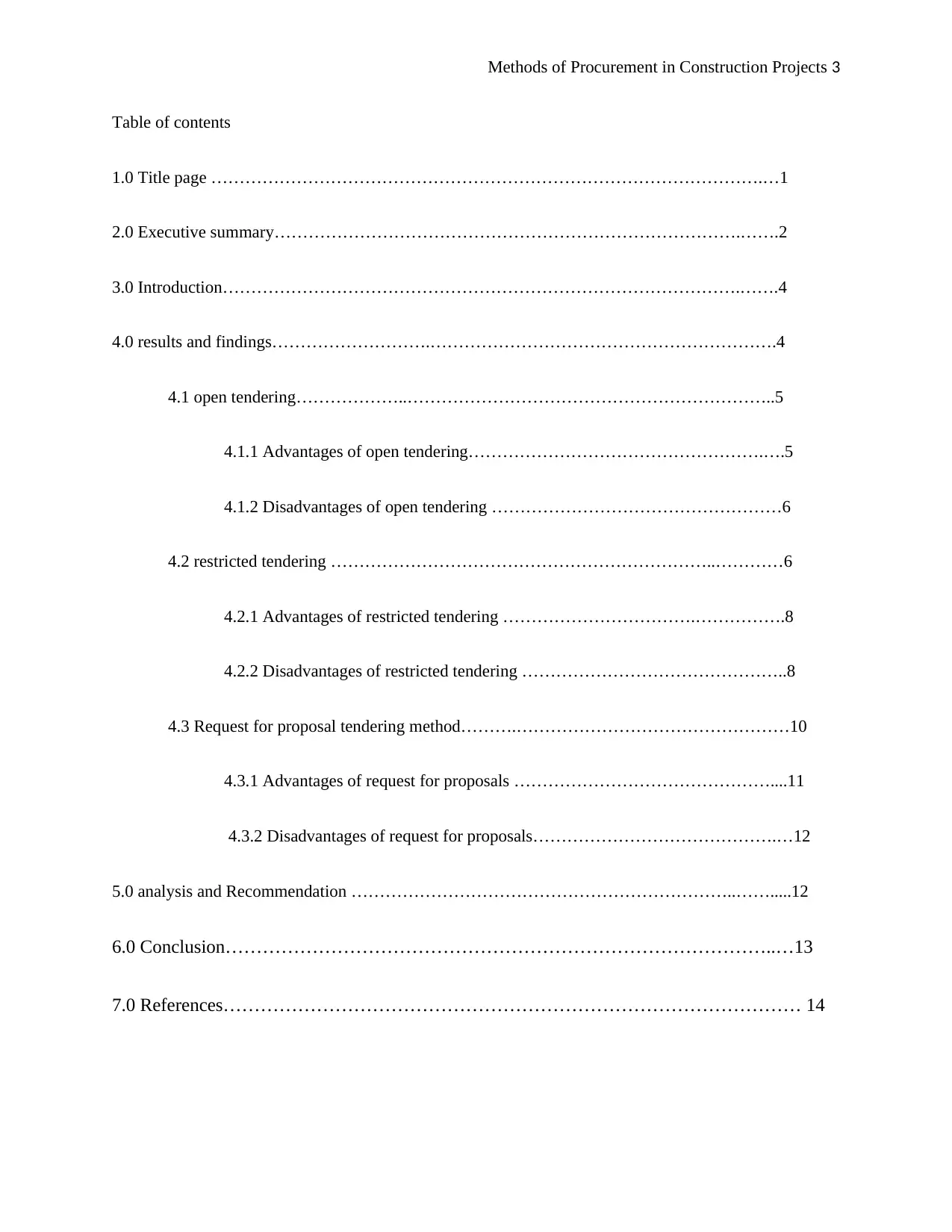
Methods of Procurement in Construction Projects 3
Table of contents
1.0 Title page …………………………………………………………………………………….…1
2.0 Executive summary……………………………………………………………………….…….2
3.0 Introduction……………………………………………………………………………….…….4
4.0 results and findings……………………….…………………………………………………….4
4.1 open tendering………………..………………………………………………………..5
4.1.1 Advantages of open tendering…………………………………………….….5
4.1.2 Disadvantages of open tendering ……………………………………………6
4.2 restricted tendering …………………………………………………………..…………6
4.2.1 Advantages of restricted tendering …………………………….…………….8
4.2.2 Disadvantages of restricted tendering ………………………………………..8
4.3 Request for proposal tendering method……….…………………………………………10
4.3.1 Advantages of request for proposals ………………………………………....11
4.3.2 Disadvantages of request for proposals…………………………………….…12
5.0 analysis and Recommendation …………………………………………………………..…….....12
6.0 Conclusion……………………………………………………………………………..…13
7.0 References………………………………………………………………………………… 14
Table of contents
1.0 Title page …………………………………………………………………………………….…1
2.0 Executive summary……………………………………………………………………….…….2
3.0 Introduction……………………………………………………………………………….…….4
4.0 results and findings……………………….…………………………………………………….4
4.1 open tendering………………..………………………………………………………..5
4.1.1 Advantages of open tendering…………………………………………….….5
4.1.2 Disadvantages of open tendering ……………………………………………6
4.2 restricted tendering …………………………………………………………..…………6
4.2.1 Advantages of restricted tendering …………………………….…………….8
4.2.2 Disadvantages of restricted tendering ………………………………………..8
4.3 Request for proposal tendering method……….…………………………………………10
4.3.1 Advantages of request for proposals ………………………………………....11
4.3.2 Disadvantages of request for proposals…………………………………….…12
5.0 analysis and Recommendation …………………………………………………………..…….....12
6.0 Conclusion……………………………………………………………………………..…13
7.0 References………………………………………………………………………………… 14
⊘ This is a preview!⊘
Do you want full access?
Subscribe today to unlock all pages.

Trusted by 1+ million students worldwide
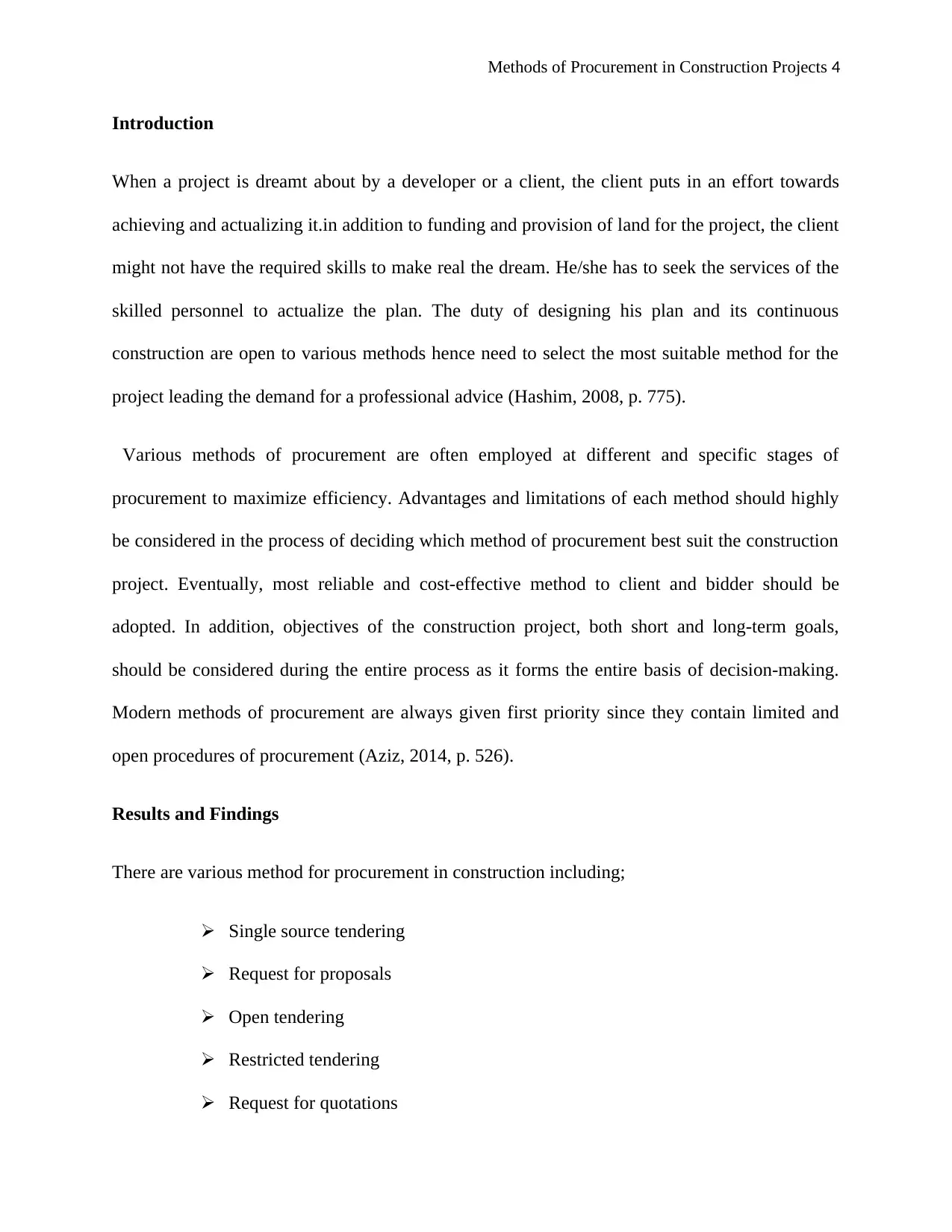
Methods of Procurement in Construction Projects 4
Introduction
When a project is dreamt about by a developer or a client, the client puts in an effort towards
achieving and actualizing it.in addition to funding and provision of land for the project, the client
might not have the required skills to make real the dream. He/she has to seek the services of the
skilled personnel to actualize the plan. The duty of designing his plan and its continuous
construction are open to various methods hence need to select the most suitable method for the
project leading the demand for a professional advice (Hashim, 2008, p. 775).
Various methods of procurement are often employed at different and specific stages of
procurement to maximize efficiency. Advantages and limitations of each method should highly
be considered in the process of deciding which method of procurement best suit the construction
project. Eventually, most reliable and cost-effective method to client and bidder should be
adopted. In addition, objectives of the construction project, both short and long-term goals,
should be considered during the entire process as it forms the entire basis of decision-making.
Modern methods of procurement are always given first priority since they contain limited and
open procedures of procurement (Aziz, 2014, p. 526).
Results and Findings
There are various method for procurement in construction including;
Single source tendering
Request for proposals
Open tendering
Restricted tendering
Request for quotations
Introduction
When a project is dreamt about by a developer or a client, the client puts in an effort towards
achieving and actualizing it.in addition to funding and provision of land for the project, the client
might not have the required skills to make real the dream. He/she has to seek the services of the
skilled personnel to actualize the plan. The duty of designing his plan and its continuous
construction are open to various methods hence need to select the most suitable method for the
project leading the demand for a professional advice (Hashim, 2008, p. 775).
Various methods of procurement are often employed at different and specific stages of
procurement to maximize efficiency. Advantages and limitations of each method should highly
be considered in the process of deciding which method of procurement best suit the construction
project. Eventually, most reliable and cost-effective method to client and bidder should be
adopted. In addition, objectives of the construction project, both short and long-term goals,
should be considered during the entire process as it forms the entire basis of decision-making.
Modern methods of procurement are always given first priority since they contain limited and
open procedures of procurement (Aziz, 2014, p. 526).
Results and Findings
There are various method for procurement in construction including;
Single source tendering
Request for proposals
Open tendering
Restricted tendering
Request for quotations
Paraphrase This Document
Need a fresh take? Get an instant paraphrase of this document with our AI Paraphraser
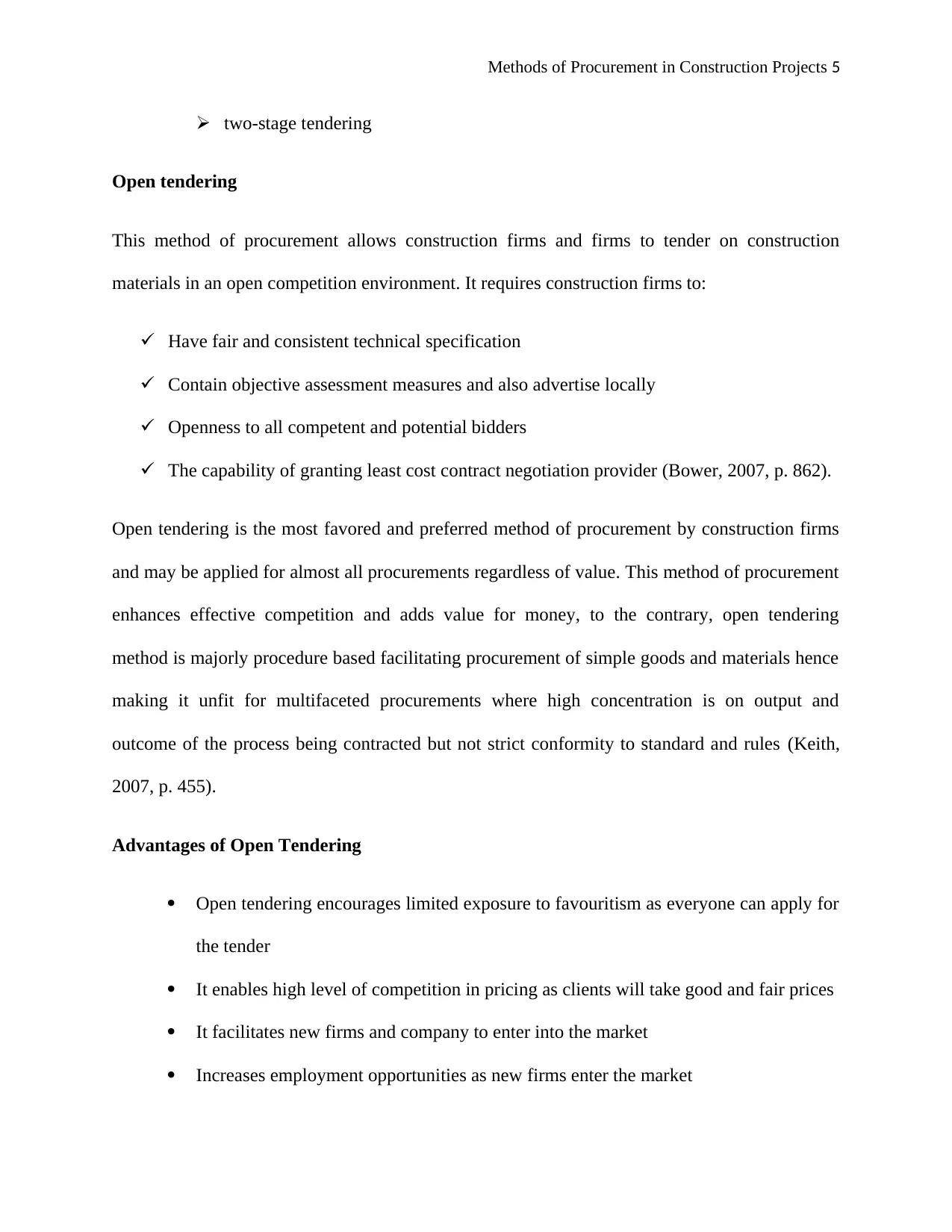
Methods of Procurement in Construction Projects 5
two-stage tendering
Open tendering
This method of procurement allows construction firms and firms to tender on construction
materials in an open competition environment. It requires construction firms to:
Have fair and consistent technical specification
Contain objective assessment measures and also advertise locally
Openness to all competent and potential bidders
The capability of granting least cost contract negotiation provider (Bower, 2007, p. 862).
Open tendering is the most favored and preferred method of procurement by construction firms
and may be applied for almost all procurements regardless of value. This method of procurement
enhances effective competition and adds value for money, to the contrary, open tendering
method is majorly procedure based facilitating procurement of simple goods and materials hence
making it unfit for multifaceted procurements where high concentration is on output and
outcome of the process being contracted but not strict conformity to standard and rules (Keith,
2007, p. 455).
Advantages of Open Tendering
Open tendering encourages limited exposure to favouritism as everyone can apply for
the tender
It enables high level of competition in pricing as clients will take good and fair prices
It facilitates new firms and company to enter into the market
Increases employment opportunities as new firms enter the market
two-stage tendering
Open tendering
This method of procurement allows construction firms and firms to tender on construction
materials in an open competition environment. It requires construction firms to:
Have fair and consistent technical specification
Contain objective assessment measures and also advertise locally
Openness to all competent and potential bidders
The capability of granting least cost contract negotiation provider (Bower, 2007, p. 862).
Open tendering is the most favored and preferred method of procurement by construction firms
and may be applied for almost all procurements regardless of value. This method of procurement
enhances effective competition and adds value for money, to the contrary, open tendering
method is majorly procedure based facilitating procurement of simple goods and materials hence
making it unfit for multifaceted procurements where high concentration is on output and
outcome of the process being contracted but not strict conformity to standard and rules (Keith,
2007, p. 455).
Advantages of Open Tendering
Open tendering encourages limited exposure to favouritism as everyone can apply for
the tender
It enables high level of competition in pricing as clients will take good and fair prices
It facilitates new firms and company to enter into the market
Increases employment opportunities as new firms enter the market
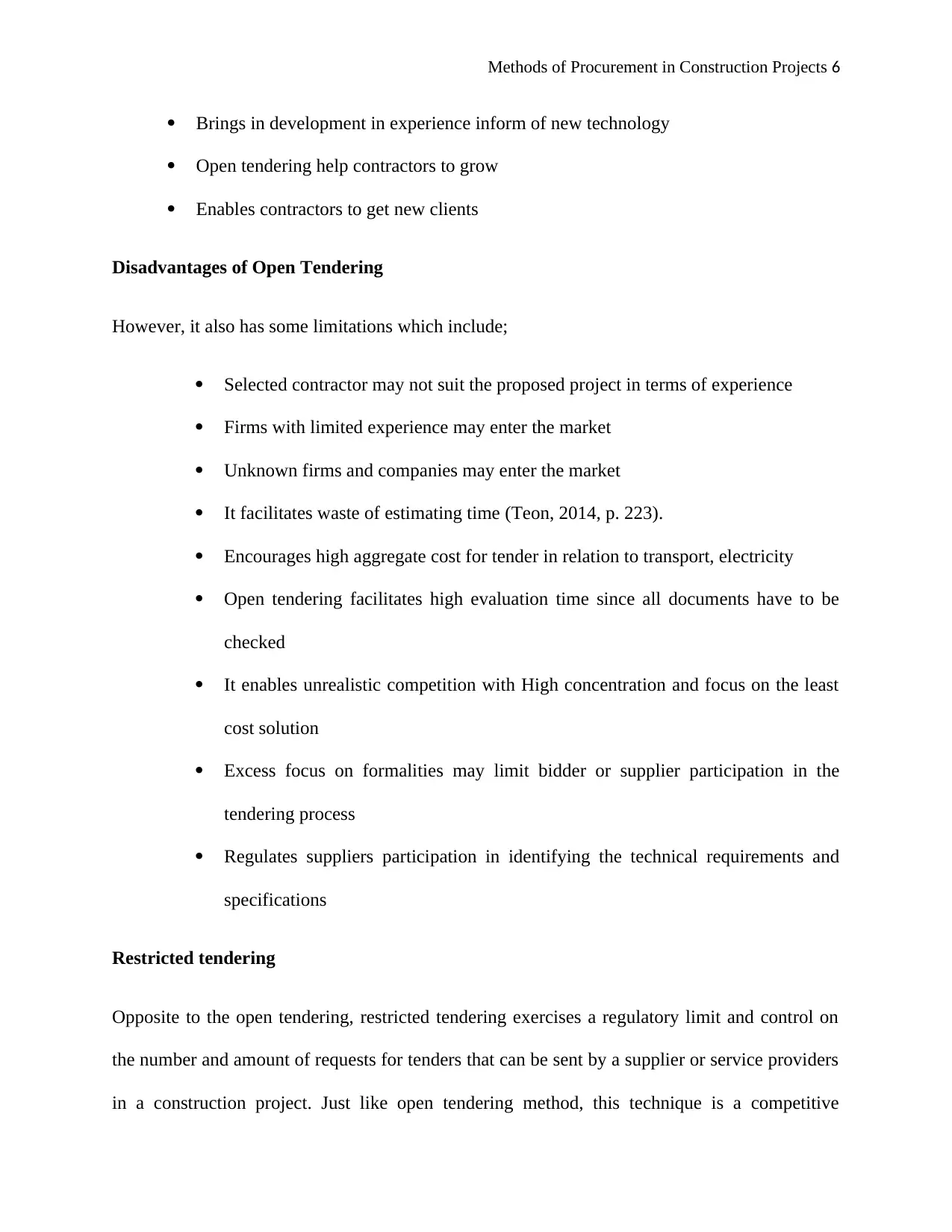
Methods of Procurement in Construction Projects 6
Brings in development in experience inform of new technology
Open tendering help contractors to grow
Enables contractors to get new clients
Disadvantages of Open Tendering
However, it also has some limitations which include;
Selected contractor may not suit the proposed project in terms of experience
Firms with limited experience may enter the market
Unknown firms and companies may enter the market
It facilitates waste of estimating time (Teon, 2014, p. 223).
Encourages high aggregate cost for tender in relation to transport, electricity
Open tendering facilitates high evaluation time since all documents have to be
checked
It enables unrealistic competition with High concentration and focus on the least
cost solution
Excess focus on formalities may limit bidder or supplier participation in the
tendering process
Regulates suppliers participation in identifying the technical requirements and
specifications
Restricted tendering
Opposite to the open tendering, restricted tendering exercises a regulatory limit and control on
the number and amount of requests for tenders that can be sent by a supplier or service providers
in a construction project. Just like open tendering method, this technique is a competitive
Brings in development in experience inform of new technology
Open tendering help contractors to grow
Enables contractors to get new clients
Disadvantages of Open Tendering
However, it also has some limitations which include;
Selected contractor may not suit the proposed project in terms of experience
Firms with limited experience may enter the market
Unknown firms and companies may enter the market
It facilitates waste of estimating time (Teon, 2014, p. 223).
Encourages high aggregate cost for tender in relation to transport, electricity
Open tendering facilitates high evaluation time since all documents have to be
checked
It enables unrealistic competition with High concentration and focus on the least
cost solution
Excess focus on formalities may limit bidder or supplier participation in the
tendering process
Regulates suppliers participation in identifying the technical requirements and
specifications
Restricted tendering
Opposite to the open tendering, restricted tendering exercises a regulatory limit and control on
the number and amount of requests for tenders that can be sent by a supplier or service providers
in a construction project. Just like open tendering method, this technique is a competitive
⊘ This is a preview!⊘
Do you want full access?
Subscribe today to unlock all pages.

Trusted by 1+ million students worldwide
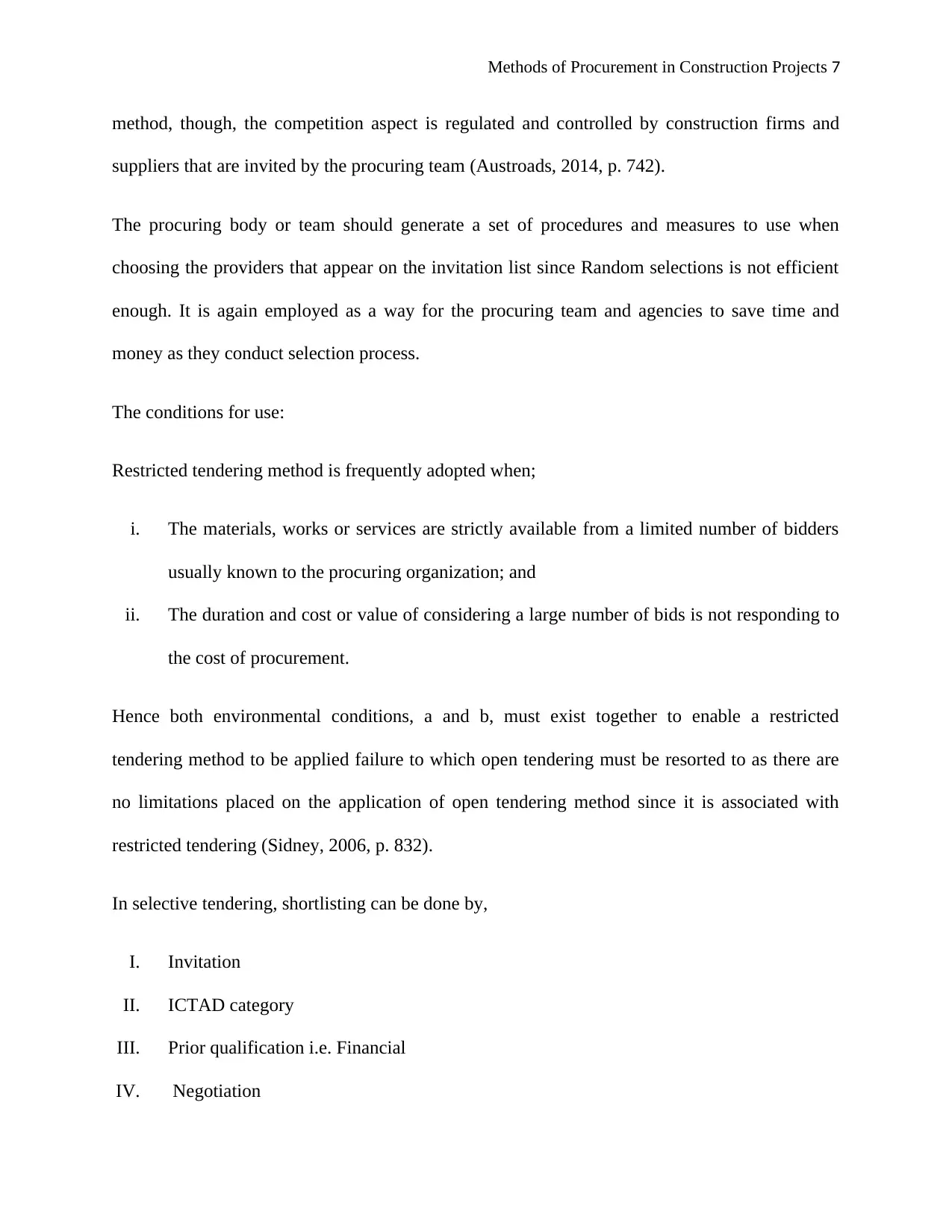
Methods of Procurement in Construction Projects 7
method, though, the competition aspect is regulated and controlled by construction firms and
suppliers that are invited by the procuring team (Austroads, 2014, p. 742).
The procuring body or team should generate a set of procedures and measures to use when
choosing the providers that appear on the invitation list since Random selections is not efficient
enough. It is again employed as a way for the procuring team and agencies to save time and
money as they conduct selection process.
The conditions for use:
Restricted tendering method is frequently adopted when;
i. The materials, works or services are strictly available from a limited number of bidders
usually known to the procuring organization; and
ii. The duration and cost or value of considering a large number of bids is not responding to
the cost of procurement.
Hence both environmental conditions, a and b, must exist together to enable a restricted
tendering method to be applied failure to which open tendering must be resorted to as there are
no limitations placed on the application of open tendering method since it is associated with
restricted tendering (Sidney, 2006, p. 832).
In selective tendering, shortlisting can be done by,
I. Invitation
II. ICTAD category
III. Prior qualification i.e. Financial
IV. Negotiation
method, though, the competition aspect is regulated and controlled by construction firms and
suppliers that are invited by the procuring team (Austroads, 2014, p. 742).
The procuring body or team should generate a set of procedures and measures to use when
choosing the providers that appear on the invitation list since Random selections is not efficient
enough. It is again employed as a way for the procuring team and agencies to save time and
money as they conduct selection process.
The conditions for use:
Restricted tendering method is frequently adopted when;
i. The materials, works or services are strictly available from a limited number of bidders
usually known to the procuring organization; and
ii. The duration and cost or value of considering a large number of bids is not responding to
the cost of procurement.
Hence both environmental conditions, a and b, must exist together to enable a restricted
tendering method to be applied failure to which open tendering must be resorted to as there are
no limitations placed on the application of open tendering method since it is associated with
restricted tendering (Sidney, 2006, p. 832).
In selective tendering, shortlisting can be done by,
I. Invitation
II. ICTAD category
III. Prior qualification i.e. Financial
IV. Negotiation
Paraphrase This Document
Need a fresh take? Get an instant paraphrase of this document with our AI Paraphraser
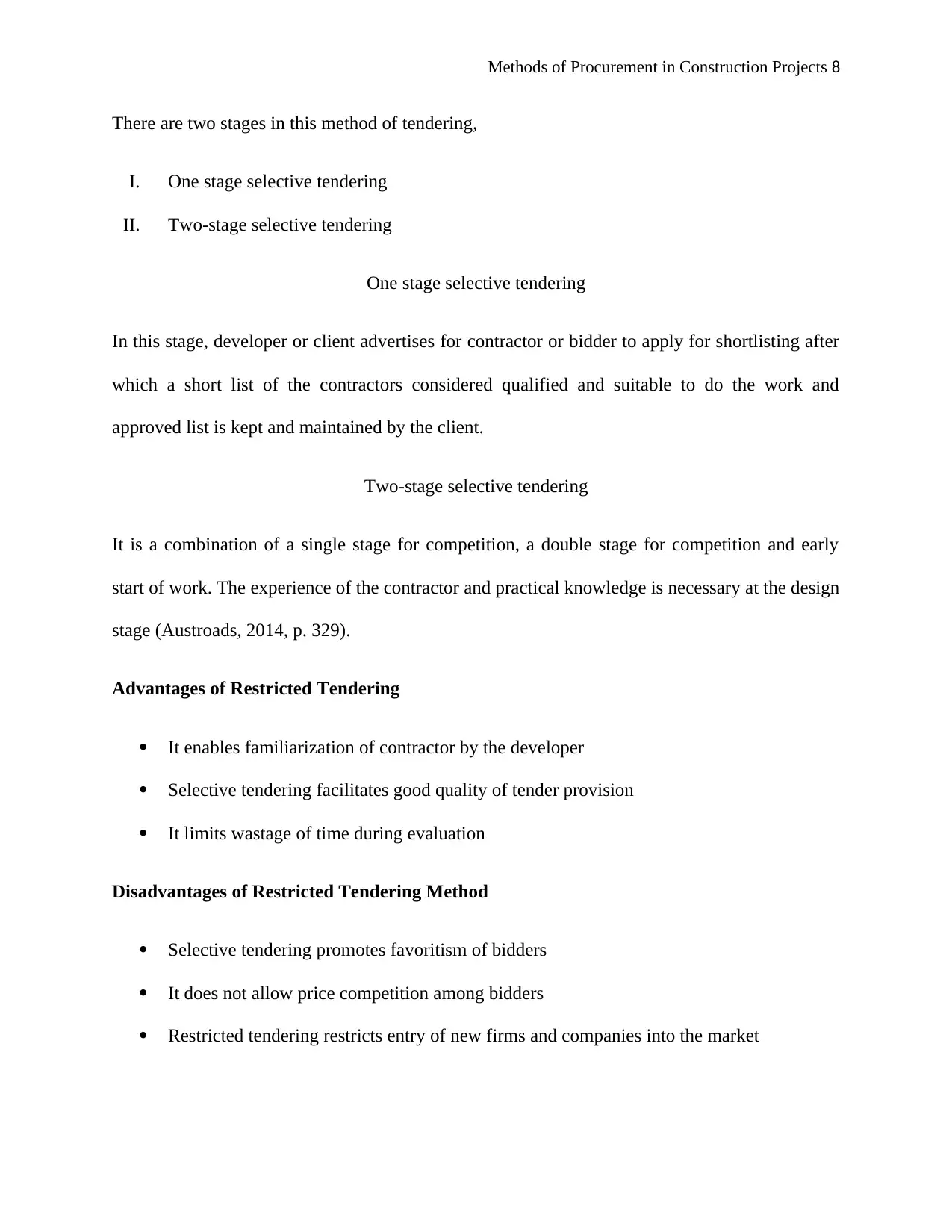
Methods of Procurement in Construction Projects 8
There are two stages in this method of tendering,
I. One stage selective tendering
II. Two-stage selective tendering
One stage selective tendering
In this stage, developer or client advertises for contractor or bidder to apply for shortlisting after
which a short list of the contractors considered qualified and suitable to do the work and
approved list is kept and maintained by the client.
Two-stage selective tendering
It is a combination of a single stage for competition, a double stage for competition and early
start of work. The experience of the contractor and practical knowledge is necessary at the design
stage (Austroads, 2014, p. 329).
Advantages of Restricted Tendering
It enables familiarization of contractor by the developer
Selective tendering facilitates good quality of tender provision
It limits wastage of time during evaluation
Disadvantages of Restricted Tendering Method
Selective tendering promotes favoritism of bidders
It does not allow price competition among bidders
Restricted tendering restricts entry of new firms and companies into the market
There are two stages in this method of tendering,
I. One stage selective tendering
II. Two-stage selective tendering
One stage selective tendering
In this stage, developer or client advertises for contractor or bidder to apply for shortlisting after
which a short list of the contractors considered qualified and suitable to do the work and
approved list is kept and maintained by the client.
Two-stage selective tendering
It is a combination of a single stage for competition, a double stage for competition and early
start of work. The experience of the contractor and practical knowledge is necessary at the design
stage (Austroads, 2014, p. 329).
Advantages of Restricted Tendering
It enables familiarization of contractor by the developer
Selective tendering facilitates good quality of tender provision
It limits wastage of time during evaluation
Disadvantages of Restricted Tendering Method
Selective tendering promotes favoritism of bidders
It does not allow price competition among bidders
Restricted tendering restricts entry of new firms and companies into the market
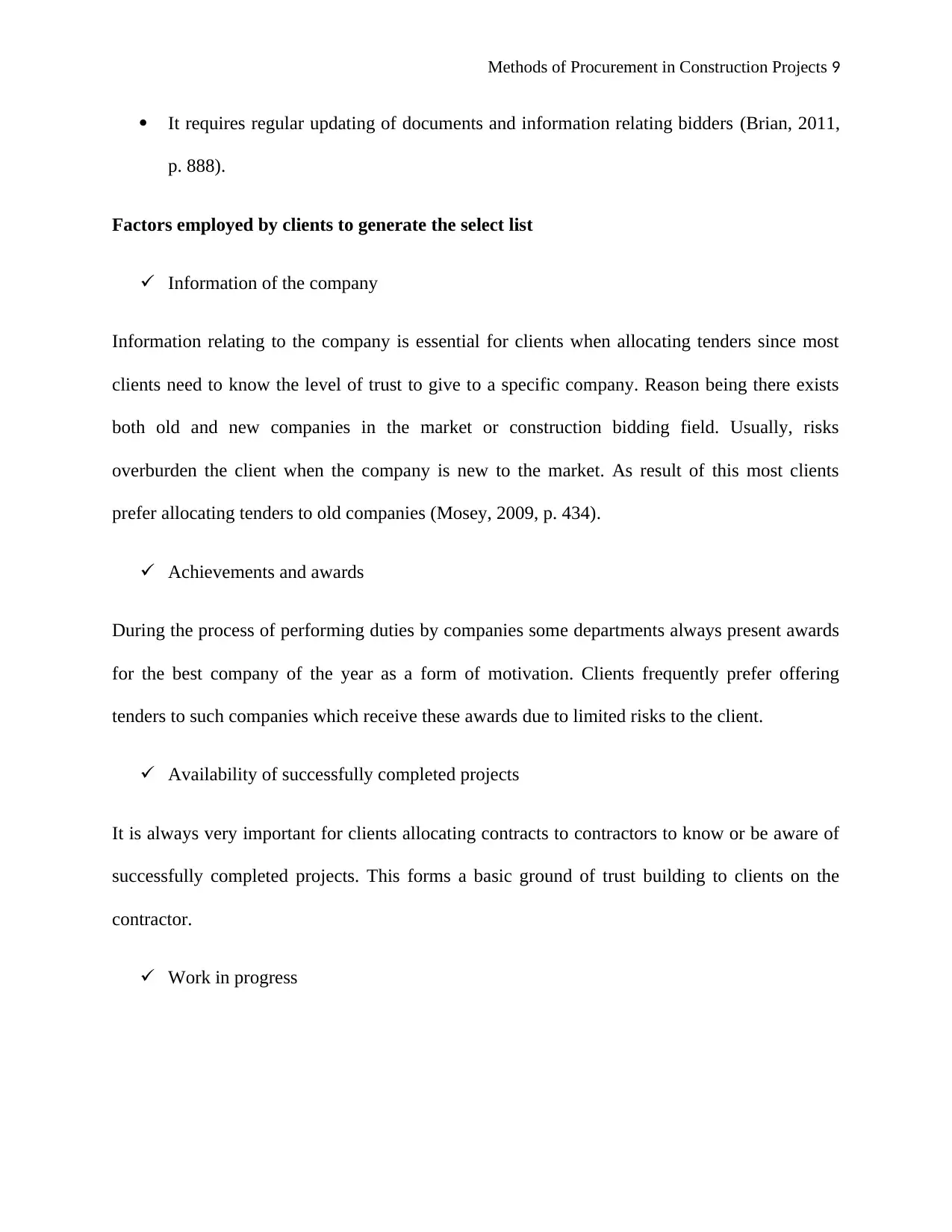
Methods of Procurement in Construction Projects 9
It requires regular updating of documents and information relating bidders (Brian, 2011,
p. 888).
Factors employed by clients to generate the select list
Information of the company
Information relating to the company is essential for clients when allocating tenders since most
clients need to know the level of trust to give to a specific company. Reason being there exists
both old and new companies in the market or construction bidding field. Usually, risks
overburden the client when the company is new to the market. As result of this most clients
prefer allocating tenders to old companies (Mosey, 2009, p. 434).
Achievements and awards
During the process of performing duties by companies some departments always present awards
for the best company of the year as a form of motivation. Clients frequently prefer offering
tenders to such companies which receive these awards due to limited risks to the client.
Availability of successfully completed projects
It is always very important for clients allocating contracts to contractors to know or be aware of
successfully completed projects. This forms a basic ground of trust building to clients on the
contractor.
Work in progress
It requires regular updating of documents and information relating bidders (Brian, 2011,
p. 888).
Factors employed by clients to generate the select list
Information of the company
Information relating to the company is essential for clients when allocating tenders since most
clients need to know the level of trust to give to a specific company. Reason being there exists
both old and new companies in the market or construction bidding field. Usually, risks
overburden the client when the company is new to the market. As result of this most clients
prefer allocating tenders to old companies (Mosey, 2009, p. 434).
Achievements and awards
During the process of performing duties by companies some departments always present awards
for the best company of the year as a form of motivation. Clients frequently prefer offering
tenders to such companies which receive these awards due to limited risks to the client.
Availability of successfully completed projects
It is always very important for clients allocating contracts to contractors to know or be aware of
successfully completed projects. This forms a basic ground of trust building to clients on the
contractor.
Work in progress
⊘ This is a preview!⊘
Do you want full access?
Subscribe today to unlock all pages.

Trusted by 1+ million students worldwide
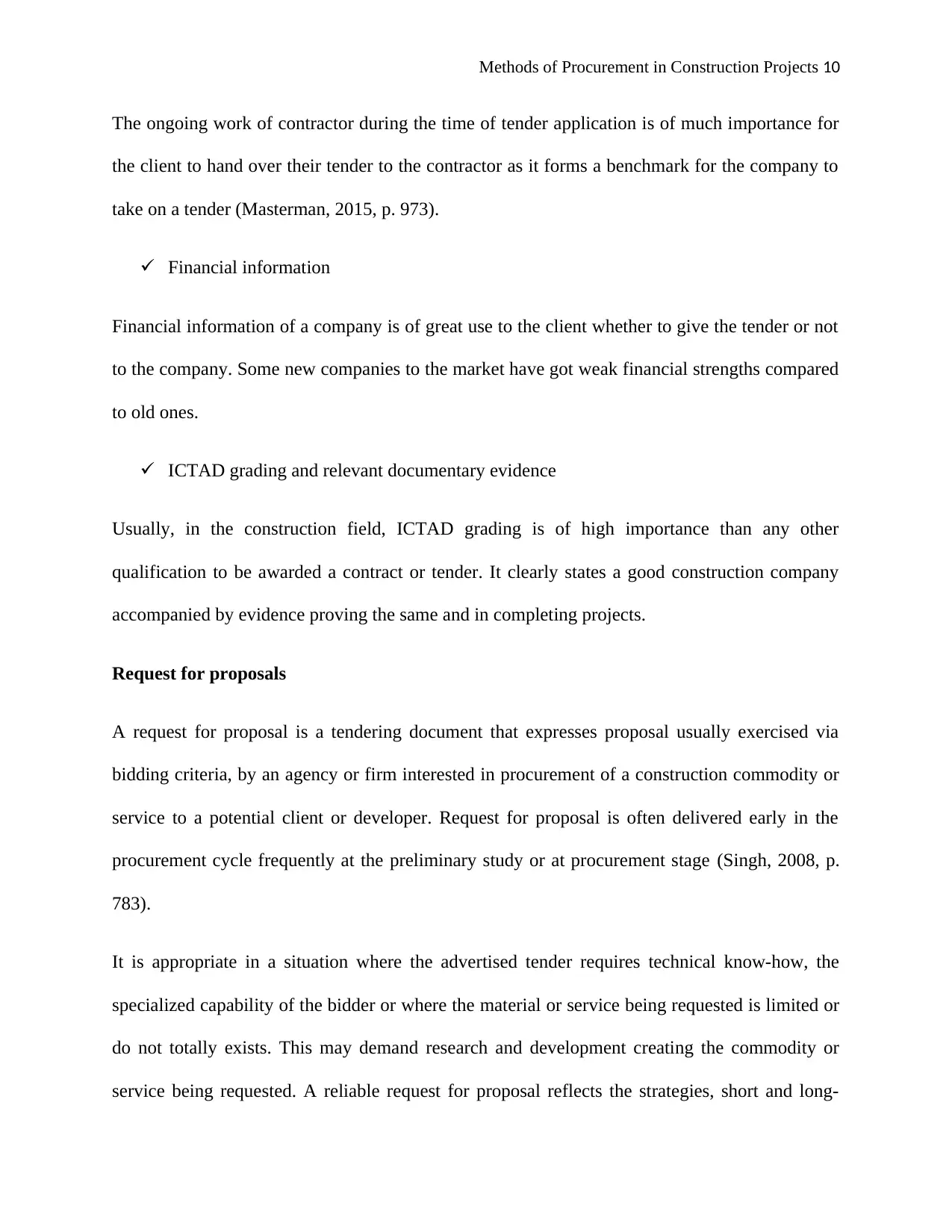
Methods of Procurement in Construction Projects 10
The ongoing work of contractor during the time of tender application is of much importance for
the client to hand over their tender to the contractor as it forms a benchmark for the company to
take on a tender (Masterman, 2015, p. 973).
Financial information
Financial information of a company is of great use to the client whether to give the tender or not
to the company. Some new companies to the market have got weak financial strengths compared
to old ones.
ICTAD grading and relevant documentary evidence
Usually, in the construction field, ICTAD grading is of high importance than any other
qualification to be awarded a contract or tender. It clearly states a good construction company
accompanied by evidence proving the same and in completing projects.
Request for proposals
A request for proposal is a tendering document that expresses proposal usually exercised via
bidding criteria, by an agency or firm interested in procurement of a construction commodity or
service to a potential client or developer. Request for proposal is often delivered early in the
procurement cycle frequently at the preliminary study or at procurement stage (Singh, 2008, p.
783).
It is appropriate in a situation where the advertised tender requires technical know-how, the
specialized capability of the bidder or where the material or service being requested is limited or
do not totally exists. This may demand research and development creating the commodity or
service being requested. A reliable request for proposal reflects the strategies, short and long-
The ongoing work of contractor during the time of tender application is of much importance for
the client to hand over their tender to the contractor as it forms a benchmark for the company to
take on a tender (Masterman, 2015, p. 973).
Financial information
Financial information of a company is of great use to the client whether to give the tender or not
to the company. Some new companies to the market have got weak financial strengths compared
to old ones.
ICTAD grading and relevant documentary evidence
Usually, in the construction field, ICTAD grading is of high importance than any other
qualification to be awarded a contract or tender. It clearly states a good construction company
accompanied by evidence proving the same and in completing projects.
Request for proposals
A request for proposal is a tendering document that expresses proposal usually exercised via
bidding criteria, by an agency or firm interested in procurement of a construction commodity or
service to a potential client or developer. Request for proposal is often delivered early in the
procurement cycle frequently at the preliminary study or at procurement stage (Singh, 2008, p.
783).
It is appropriate in a situation where the advertised tender requires technical know-how, the
specialized capability of the bidder or where the material or service being requested is limited or
do not totally exists. This may demand research and development creating the commodity or
service being requested. A reliable request for proposal reflects the strategies, short and long-
Paraphrase This Document
Need a fresh take? Get an instant paraphrase of this document with our AI Paraphraser
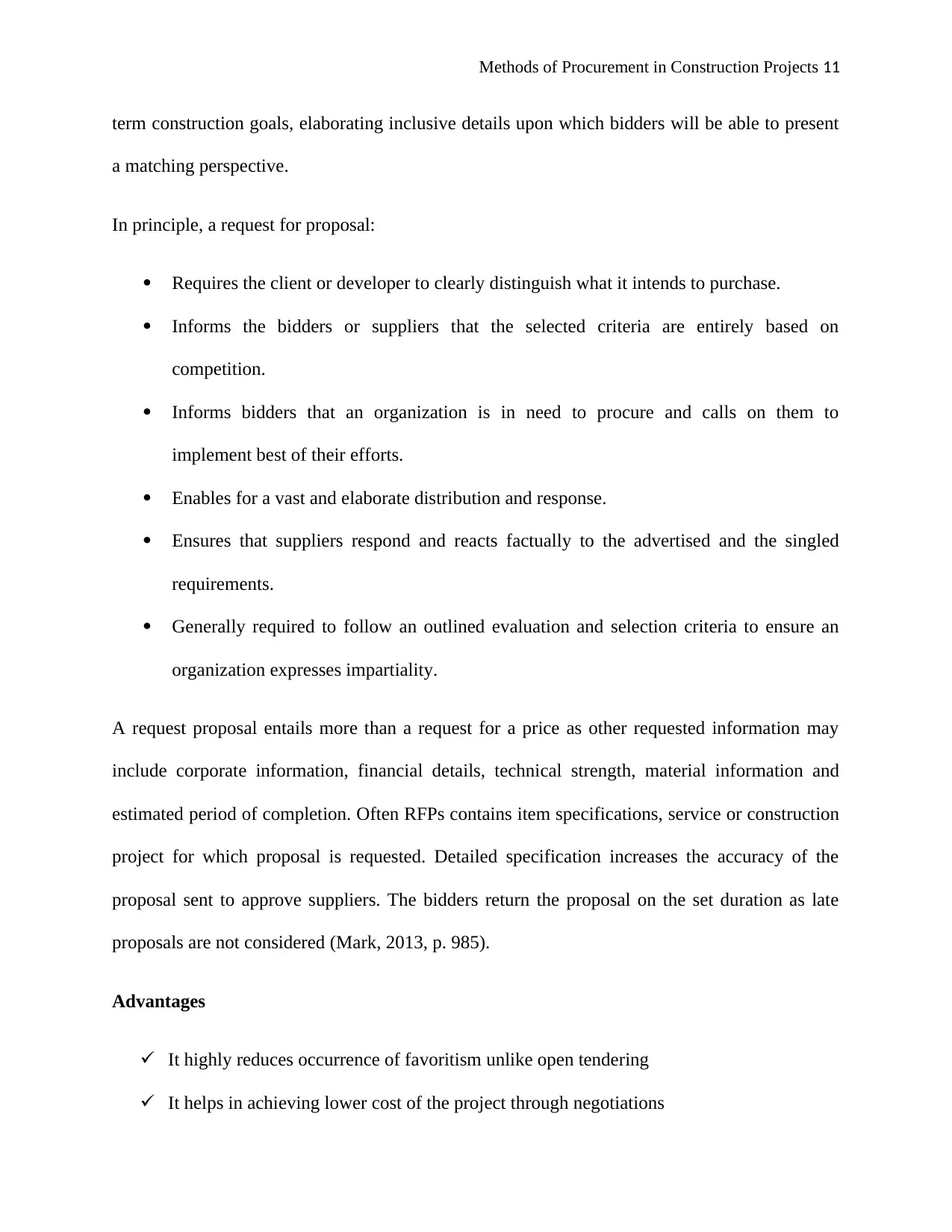
Methods of Procurement in Construction Projects 11
term construction goals, elaborating inclusive details upon which bidders will be able to present
a matching perspective.
In principle, a request for proposal:
Requires the client or developer to clearly distinguish what it intends to purchase.
Informs the bidders or suppliers that the selected criteria are entirely based on
competition.
Informs bidders that an organization is in need to procure and calls on them to
implement best of their efforts.
Enables for a vast and elaborate distribution and response.
Ensures that suppliers respond and reacts factually to the advertised and the singled
requirements.
Generally required to follow an outlined evaluation and selection criteria to ensure an
organization expresses impartiality.
A request proposal entails more than a request for a price as other requested information may
include corporate information, financial details, technical strength, material information and
estimated period of completion. Often RFPs contains item specifications, service or construction
project for which proposal is requested. Detailed specification increases the accuracy of the
proposal sent to approve suppliers. The bidders return the proposal on the set duration as late
proposals are not considered (Mark, 2013, p. 985).
Advantages
It highly reduces occurrence of favoritism unlike open tendering
It helps in achieving lower cost of the project through negotiations
term construction goals, elaborating inclusive details upon which bidders will be able to present
a matching perspective.
In principle, a request for proposal:
Requires the client or developer to clearly distinguish what it intends to purchase.
Informs the bidders or suppliers that the selected criteria are entirely based on
competition.
Informs bidders that an organization is in need to procure and calls on them to
implement best of their efforts.
Enables for a vast and elaborate distribution and response.
Ensures that suppliers respond and reacts factually to the advertised and the singled
requirements.
Generally required to follow an outlined evaluation and selection criteria to ensure an
organization expresses impartiality.
A request proposal entails more than a request for a price as other requested information may
include corporate information, financial details, technical strength, material information and
estimated period of completion. Often RFPs contains item specifications, service or construction
project for which proposal is requested. Detailed specification increases the accuracy of the
proposal sent to approve suppliers. The bidders return the proposal on the set duration as late
proposals are not considered (Mark, 2013, p. 985).
Advantages
It highly reduces occurrence of favoritism unlike open tendering
It helps in achieving lower cost of the project through negotiations
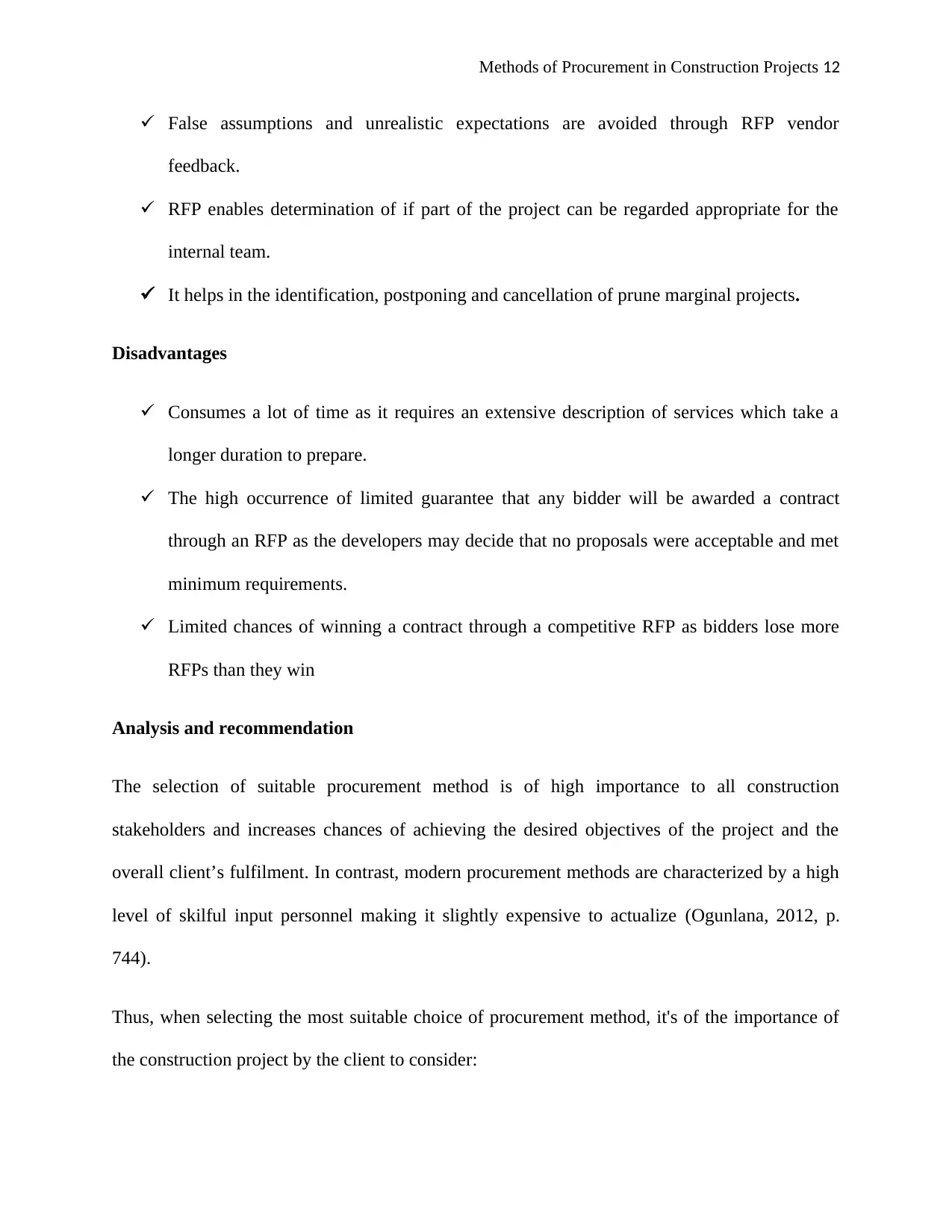
Methods of Procurement in Construction Projects 12
False assumptions and unrealistic expectations are avoided through RFP vendor
feedback.
RFP enables determination of if part of the project can be regarded appropriate for the
internal team.
It helps in the identification, postponing and cancellation of prune marginal projects.
Disadvantages
Consumes a lot of time as it requires an extensive description of services which take a
longer duration to prepare.
The high occurrence of limited guarantee that any bidder will be awarded a contract
through an RFP as the developers may decide that no proposals were acceptable and met
minimum requirements.
Limited chances of winning a contract through a competitive RFP as bidders lose more
RFPs than they win
Analysis and recommendation
The selection of suitable procurement method is of high importance to all construction
stakeholders and increases chances of achieving the desired objectives of the project and the
overall client’s fulfilment. In contrast, modern procurement methods are characterized by a high
level of skilful input personnel making it slightly expensive to actualize (Ogunlana, 2012, p.
744).
Thus, when selecting the most suitable choice of procurement method, it's of the importance of
the construction project by the client to consider:
False assumptions and unrealistic expectations are avoided through RFP vendor
feedback.
RFP enables determination of if part of the project can be regarded appropriate for the
internal team.
It helps in the identification, postponing and cancellation of prune marginal projects.
Disadvantages
Consumes a lot of time as it requires an extensive description of services which take a
longer duration to prepare.
The high occurrence of limited guarantee that any bidder will be awarded a contract
through an RFP as the developers may decide that no proposals were acceptable and met
minimum requirements.
Limited chances of winning a contract through a competitive RFP as bidders lose more
RFPs than they win
Analysis and recommendation
The selection of suitable procurement method is of high importance to all construction
stakeholders and increases chances of achieving the desired objectives of the project and the
overall client’s fulfilment. In contrast, modern procurement methods are characterized by a high
level of skilful input personnel making it slightly expensive to actualize (Ogunlana, 2012, p.
744).
Thus, when selecting the most suitable choice of procurement method, it's of the importance of
the construction project by the client to consider:
⊘ This is a preview!⊘
Do you want full access?
Subscribe today to unlock all pages.

Trusted by 1+ million students worldwide
1 out of 15
Related Documents
Your All-in-One AI-Powered Toolkit for Academic Success.
+13062052269
info@desklib.com
Available 24*7 on WhatsApp / Email
![[object Object]](/_next/static/media/star-bottom.7253800d.svg)
Unlock your academic potential
Copyright © 2020–2025 A2Z Services. All Rights Reserved. Developed and managed by ZUCOL.





